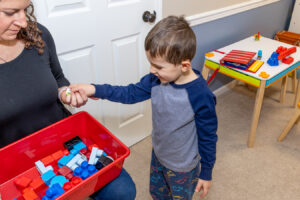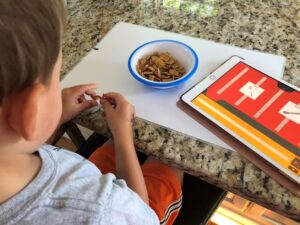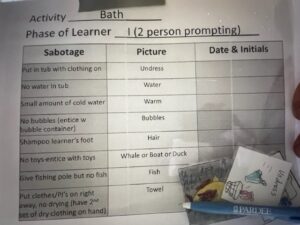By Jaime Wedel, M.Ed., CAGS, BCBA
In order to be successful with PECS® teams not only have to know how to implement the protocol correctly they have to be able to implement communication training across each learner’s day. Here are some tips to help your learners succeed!
Setting the Stage for Success
First, with any skill, we need to provide the learner with ample opportunities to master the skill. In PECS, we have long noted this pattern, both in reviews of the over 200 articles examining the effectiveness of PECS and through our own experience as an international team of professionals led by the developers of PECS, Lori Frost, MS, CCC-SLP and Andy Bondy, PhD.
Secondly, we must implement communication training across the day to ensure generalization of skills. There is no “generalization fairy” who is going to come in the night and tell our learners that the picture exchange skill they learned to play with a favorite item in a professional’s office applies when they want a grandparent to push them on the swing set at home. A big part of our job is to show our learners, “Communication works all across the day, with anyone, for anything, in any setting!” Ideally, good PECS teaching happens within structured lessons and during what we call, “Stop, drop, and communicate” opportunities in during the learner’s day-to-day life.
Using the Right Tools for the Job
The team should have done a reinforcer assessment with every learner and be updating this at least monthly. Every learner should have a bin or a box with some of their reinforcers in it, and these should be rotated frequently to maintain the student’s interest. Parts of the student’s day can involve focused teaching during which they are working for items in the bin.
However, the most important opportunities occur in real-life, because that’s where we want the learner to be using their communication skills long-term! A good professional should be helping the team survey the day for routines, such as getting dressed, school arrival and dismissal, preparing meals and eating, watching television, and self-care such as bathing.
Encouraging Communication

We see it as part of a good communication teacher’s job to help the team identify and know how to use these opportunities across the day. I like to help my team make lists of possible “Oh shoots” for routines and have these lists available throughout the classroom and home. Be explicit with the list-do not just say- “Don’t give needed items at snack time.” Instead say, “Put the snack in a container the student cannot open” (and have the container and pictures ready at the snack table!). We generally can come up with lists of five, or even ten or more ideas for a routine, and it is important to stress to the team, we do not expect them to do all five every day. We want them to pick one or two today, and then a different two or three tomorrow. Maybe the next day we do none, both due to our own busy schedule, and also as a time to allow the learner to practice the routine correctly.
When you are using this strategy, sometimes the learner will not notice there is a problem. I once made cookies with a learner and did not have a spoon to stir the batter, and he simply put his hand in to do it with no indication at all that he saw a problem with that. In those cases, I say, “Oops, my mistake” and provide the spoon. Then I will stop using that “Oh shoot” for a time, and maybe try it again later when the student has more baking experience. We do NOT advocate for “waiting the student out” as the lesson is not, “Ask for a spoon fifteen minutes later.” We also need to be prepared to start teaching quickly, before a student may engage in challenging behaviors.
Planning It Out
It is important that we PLAN for communication across the day. We will not provide enough teaching opportunities if we simply “try to remember” in a busy day. Our teams have found the following resources useful. Check them all out and use any that are a good fit for the people you work with:
- Routines and Communication in the Home and Classroom Worksheet©: This worksheet helps a team look at each activity to determine the full range of communication skills that can be taught to learners in various Phases of PECS. To download for free, visit our Free Materials page and download the PECS Data Forms in the Information on PECS section. This worksheet can be found in the Worksheets folder.
- Communication Programming Across the Day©: When a learner has mastered specific daily routines (brushing teeth, washing hands, arriving at school, etc.) and finds participating in or finishing the routine reinforcing because of what happens after the routine (i.e., a learner who knows how to wash his hands, and is motivated to wash his hands because snack will follow) this worksheet is helpful. To download for free, visit our Free Materials page and download the PECS Data Forms in the Information on PECS section. This worksheet can be found in the Worksheets folder.
- Our Support at Home page provides videos of many fun activities, and includes lesson plans showing how to incorporate communication into the activities, as well as free Pics for PECS® picture grids for the learner to use.

Additional Support
To learn more about expanding communication opportunities across the day for your learner, attend the PECS Level 2 Training! This two-day training focuses on creating lessons and activities to promote communication throughout the day and is offered remotely each month. Beginning with a review of the Pyramid Approach to Education® as it relates to PECS, we guide you in refining your PECS implementation and discuss current challenges you have experienced within the six phases. Prerequisite: PECS Level 1 Training.
For ongoing support with your PECS implementation, join our online community on Facebook. Search “PECS User Support” on Facebook and request to join. This active group of over 27,000 professionals, parents, and caregivers is monitored by our Pyramid Consultants from around the globe daily!
© Pyramid Educational Consultants, LLC. 2022
